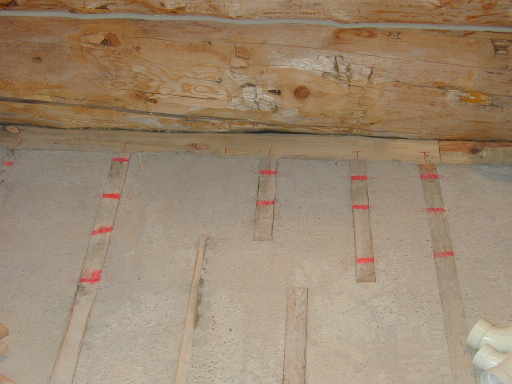
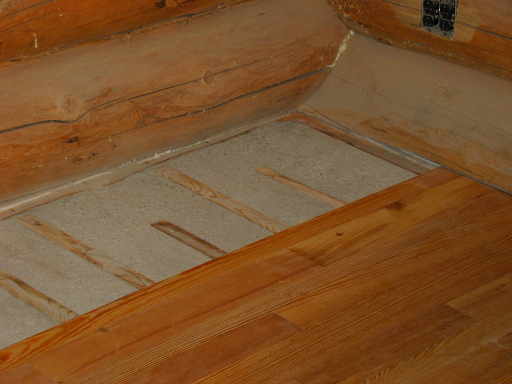
About half the floors in our house are antique southern heart pine. The boards are full 3/4" thickness tongue-and-groove individual boards of varying width. They are laid over a radiant base floor in 1-7/8" concrete.
When deciding on the actual flooring, I was concerned about expansion and contraction problems causing cracks to open between the boards. When you read about hardwood radiant floors, most installers make a big issue of this. As a result, I looked for and purchased antique heart pine because of its very tight growth rings which should result in less shrinkage. However, as you can see from some of the photographs, the boards were not quarter-sawn and as a consequence a number of them have rather large rings.
In spite of that, we have had absolutely no problems with shrinkage. Eleven years later, despite the fact that we live in an extreme climate where the temperature ranges from over 100 degrees Fahrenheit in the summer to below 30 degrees below zero Fahrenheit in the winter, the floor is as tight as the day it was put down. We do, however, have a relatively dry climate, so moisture issues are minimal. I suspect the primary reason for our tight floors, other than care in installation, is that our radiant floor is run by a ground source heat pump and not a conventional boiler. The maximum design water temperature for the heat pumps is 130 degrees Fahrenheit, whereas in a conventional boiler application the max design temperature is usually around 180 degrees. Because the house is relatively tight and relatively well insulated, in spite of being a log home, the highest water temperature we have actually seen is 130 degrees at the heat pump. The house temperature ranges from 50 degrees Fahrenheit on occasions when we are gone in the winter, to about 80 degrees Fahrenheit in the summer. As a consequence, the floors see a very small range of temperature variation.
Unfortunately, I did not take any pictures of the construction of the radiant subfloor, but I'll describe it. The sub-floor is rough cut 1" pine run diagonally and screwed down to rough cut 2" x 12" floor joists on 16" centers. The sub-floor boards are run diagonally so that when the nailers are put down on top of the sub-floor, the nailers will not be running parallel to the sub-floor boards (The sub-floor boards have to run either across or diagonal to the joists to prevent sag; and the nailers should run across the joists). Six mil polyethylene was stapled to the sub-floor, and 1-7/8" x 1-7/8" planed nailers are installed over the sub-floor. The nailers were screwed down using 4" deck screws.
The maximum length of a radiant floor circuit is about 250 feet, so most of our floors had more than one loop in them. Because of our harsh climate, I wanted 6" spacing of the radiant tubing, and I wanted the floor nailed down at least every 12". A 6" spacing would mean there would only be 4" of heated concrete in every 6" of floor, and I was not happy with that. So I settled on 8" spacing between nailers, which left 6" of concrete.
In figuring out the layout for the loops, you have to account for the lead-in and return of the tubing to the manifold for each loop. Once that is figured out, you can lay out the nailers and screw them down. As you can see from the photographs, every other nailer ends about 6" from the end of the wall. That is where the PEX tubing bends around and goes back in the next space between nailers. The PEX tubing was supported in the middle of the 6" space using special nail-down brackets every few feet. You want the tubing off the sub-floor but below the top of the nailer; ideally, in the middle of the space.
When putting down the nailers, try very hard to get them absolutely even with each other on the top. If they aren't, your floor will be wavy or have creaks in it. Level is good, but flat is even more important. Shim them if necessary. I think mine were good within about 1/16" inch.
Once the nailers are down, there are some important things to do before pouring concrete. Depending on how you ran the PEX tubing and the configuration of your nailers, you may have tubing runing through holes in the nailers. It is imperative that you mark those places where tubing goes through a nailer, so later on you can avoid driving a flooring nail there. I marked mine with a pencil and then red fluorescent paint.
Then it's time to pour concrete. Many radiant floors use gypcrete, as it is quite a bit lighter than regular concrete. However, it does not conduct heat as well, and you want as much heat as possible transferred to the floorboards, particularly if using a relatively low-temperature ground source heat pump as your heat source. So I opted to use regular concrete, using a pea-gravel aggregate. We used a pump and hose to put it down so we could direct it along the space between nailers.
Once the concrete has set enough to walk on, clean the nailers and make sure you can still see the marks where tubing goes through them. After the concrete has cured, it looks something like the photo below. The odd extra-wide channel on the right (about 10") has a double run of PEX tubing in it with no nailer between; I can't remember why.
 |
 |
| Ready for Flooring | Part way done |
Now you're ready to put the actual flooring down. I put a layer of 15# felt down between the concrete / nailers and the flooring. My thinking was that it would cushion the floor a little, even out some imperfections in the concrete, and not insulate the floor too much from the concrete.
Before putting down the felt, you need to mark where the nailers are. In my case, the only place we had gaps (missing) nailers was up next to a wall, as in the above photo. In addition, the only places we had tubing running through a nailer was also near a wall. This was usually only on one wall, so for the rest of the floor I simply needed to mark where the nailer was at the edge of the felt that was already down (or the start of the floor), roll out a strip of felt, and snap a chalk-line from the mark at the edge of the previous felt / start and the center of the nailer where it emerged from the new felt.
However, as you near the wall with missing nailers and tubing running through nailers, you need to carefully measure and mark where the nailers end and where tubing goes through the nailers. Then roll out the felt, and mark the felt.
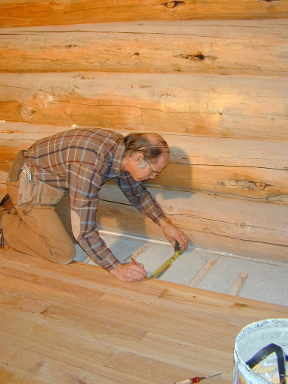 |
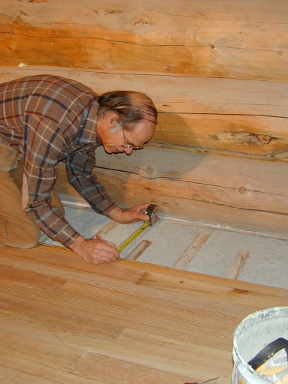 |
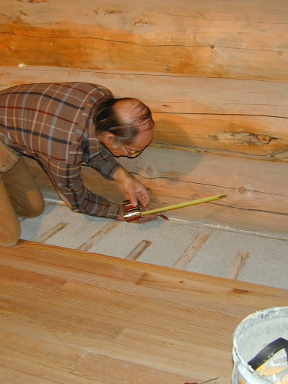 |
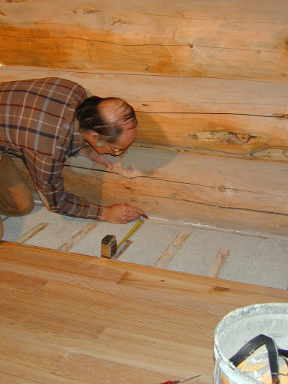 |
| Marking nailer position on edge of last board | Measuring and recording length of nailer remaining | Marking position of nailer at edge of wall | Marking position of nailer at edge of wall |
 |
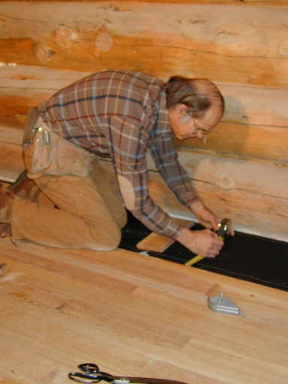 |
 |
| Stapling felt to nailers | Marking end of nailer on felt | Snapping line on center of nailer |
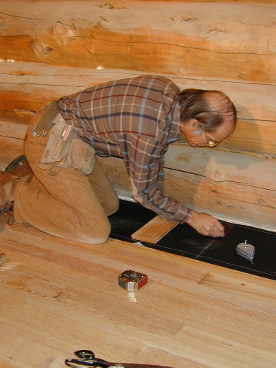 |
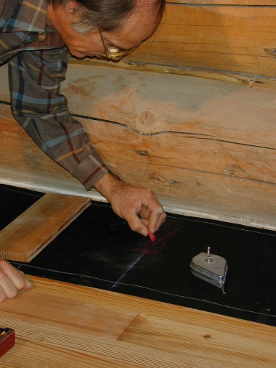 |
| Marking end of nailer and tubing crossings | Marking void (no nailer) conspicuously |
Once everything is marked, lay out a row of flooring and cut the ends square for butt-joints. When ordering flooring, conventional advice is to allow for 5% waste due to short ends which aren't used. In addition, if putting flooring down over nailers at some spacing, one normally allows an additional 5% for the waste which is cut off at the end of a board so that the joints are all over a nailer. This prevents the ends poking up and being uneven if the wood moves, and prevents squeeking of that loose end. However, with a little more work you can avoid this waste. I decided to biscuit the ends of each board to the next one. In that way there is no waste unless you end up with an extremely short piece, and you can usually swap pieces to avoid that. I ordered the extra flooring before I had figured this out, and I ended up with enough left over flooring to do a whole additional room.
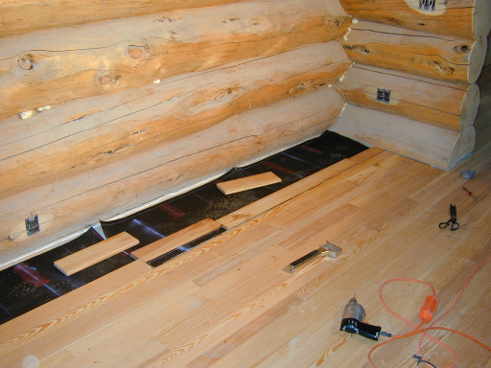 |
| Marked felt with flooring ready to nail |
After laying out and cutting the boards to length, cut a biscuit slot in the end of the first board. Tap it into place, using a piece of scrap with the groove in it as a block so you don't damage the tongue on the new piece. Drill a hole for the nail in the end of the board against the wall, to prevent it splitting since it's so near the end of the board. Then nail it in place. Don't nail all the way, or you will damage the top of the floorboard. The nail is driven home using a nail set.
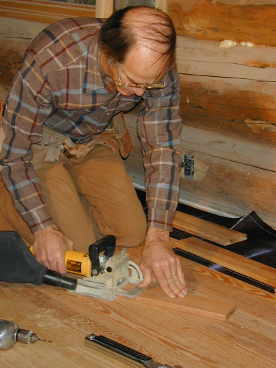 |
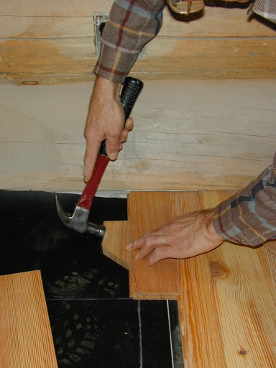 |
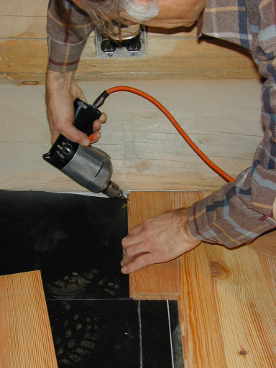 |
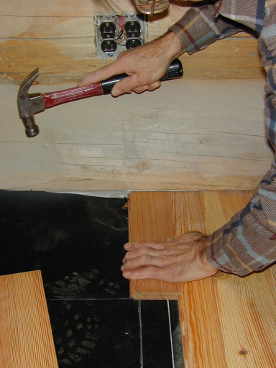 |
| Cutting biscuit slot in the end | Tapping board in place | Drilling for end nail | Nailing the end |
If the end of the board is close to a nailer, you should drill that hole also to prevent splitting that end of the board as well.
 |
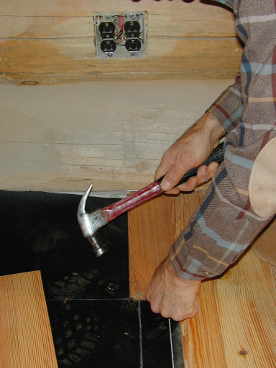 |
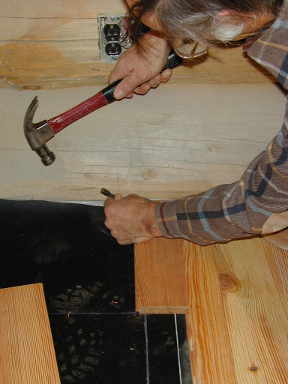 |
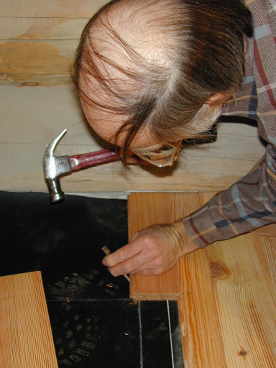 |
| Drilling for end nail | Nailing the end | Setting nail at wall end | Setting nail on running end |
It's probably best to lay out a whole row at once, to get the joints offset from the previous row. You don't want to have two joints adjacent between the same two nailers if you can help it, even if they are biscuited together. Cut the ends of all the boards square. Once the whole row is laid out, cut biscuit slots in all of them at once. But double check to be sure all biscuit slots are cut in the new board before starting to glue, because mistakes always happen. You probably want to leave the last board long, and cut it at the very end just before putting it in place, in case there were small gaps in the fitting process. Small gaps can add up to a large gap at the end.
Before getting out the glue bottle, check if there are any voids or tubing holes marked on the felt for any of the nailers under the new board. If there are, put the board tight up to its neighbor and mark on the top of the board the places not to nail.
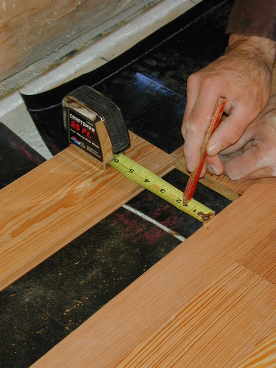 |
 |
Put glue on the biscuit, and on the end of the board. Make sure you put it on the end which goes next to the end already nailed down. You'll mess up occasionally and do the wrong end. Depending on the glue, you may or may not have time to work with it... When you insert the biscuit, make sure it is in the center of its slot; there should be a little gap in the biscuit slot at each end. If it's not centered, the boards won't snug up properly. Put the board in place and tap it next to the existing run of boards, using a block to avoid dinging the tongue (missing in the photo below...), then tap the board and biscuit tight to the previous board using a block against the end to prevent dinging up the end.
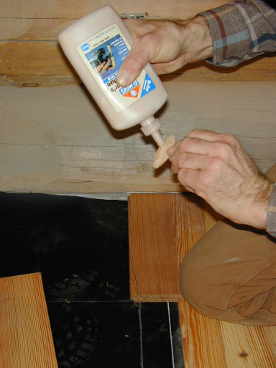 |
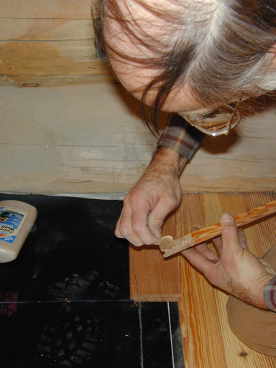 |
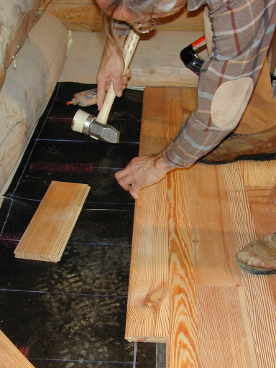 |
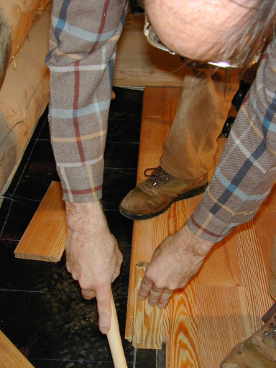 |
| Putting glue on a biscuit | Smearing glue on the end of the new board | Tapping the board with biscuit in place | Snugging the board and biscuit |
Make sure the new board is tight to the previous row, then nail it in place where the nailers are marked. If the nailer is not too close to the end of the board, no holes need to be drilled; but if they are near the ends, drill them to avoid splitting out the ends.
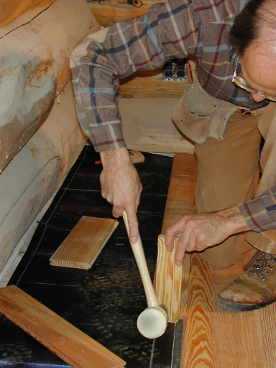 |
 |
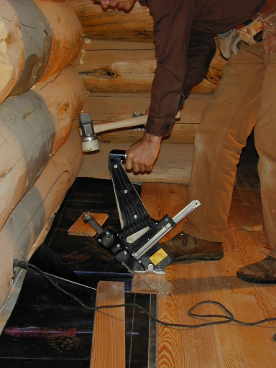 |
| Driving the board and biscuit home | Snugging the board to the previous row | Nailing the new board in place |
And so on until the floor is done. For my floor, which is resawn lumber and has numerous flaws in it (on purpose), I don't mind having a few nails showing, so when I got too close to the wall to use the nailer, I used a nail gun and face-nailed the last few boards. Otherwise you can face nail, set the nails, and fill the holes before finishing.
If you have questions or comments, you may contact me at garya at this domain.